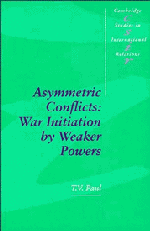Book contents
1 - Introduction: war initiation in international relations theory
Published online by Cambridge University Press: 03 May 2011
Summary
This book addresses the question of war initiation in asymmetric conflicts – a conflict in which two states with unequal power resources confront each other on the battlefield. In most theoretical discussions on war, not much attention has been paid to the basic question under investigation here: Why does a militarily and economically less powerful state initiate war against a relatively strong state? Examples of asymmetric wars in which the weaker side attacked its stronger opponent abound. Prominent ancient cases include the Spartan attack on a coalition of Athens, Corinth, and Argos in 394 BC, Pyrrus' attack on Italy in 275 BC, the several Gallic, Gothic, and Heruli invasions of the Roman Empire in the third century AD, and the Muslim invasion of Persia in AD 636.
In the modern era, a number of such wars have occurred. For instance, Frederick the Great possessed an inferior force level when he waged the Seven Years' War against Austria. In fact, his 30,000-strong Prussian Army beat an Austrian force of 80,000 at Leuthen. The Hungarian attack on Turkey in 1747 is another case of this nature. The initiators of the First Balkan War in 1912 – Bulgaria, Serbia, and Greece – possessed a combined force smaller than that of their target state, Turkey, and yet were able to defeat their superior adversary.
- Type
- Chapter
- Information
- Asymmetric ConflictsWar Initiation by Weaker Powers, pp. 3 - 14Publisher: Cambridge University PressPrint publication year: 1994
- 1
- Cited by



